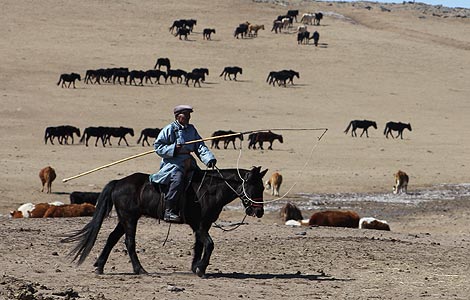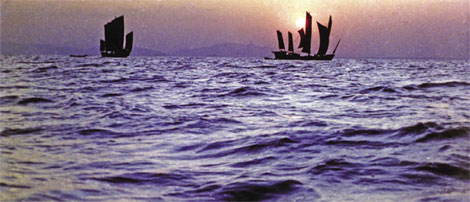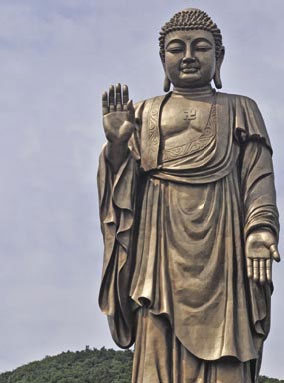Pearl on the Yangtze
Updated: 2011-06-10 11:36
By Yang Yang (China Daily)
|
|||||||||||
|
Taihu lake is the dominate natural feature of Wuxi. Surrounding the lake are lovely parks and gardens, which are some of the best examples of classical Chinese gardens in the nation. Bei Huan / For China Daily |
The bright lights of Shanghai seem to outshine many places in modern China, but only 128 kilometers away gleams another gem that is just as bright and beautiful. Wuxi is a classic jiangnan (south Yangtze River) city, with a beautiful landscape and stunning Chinese gardens. To the Chinese people this city of grace and vitality is known as the "pearl of Taihu Lake".
Situated in East China's Jiangsu province, it is one of the country's oldest cities with a history of more than 3,000 years. A land famous for fish and rice, Wuxi and its surrounding area today is a major center for textile and electronic industries.
|
The grand Buddha at Lingshan stands 88 meters tall and is one of the biggest Buddhist statues in China. |
The city attracts many foreign business people and there is plenty to see. Here are five suggestions.
1. Turtle Head Islet
Turtle Head Islet (Yuantou Zhu) is considered the best scenic spot on Taihu Lake, a waterway that dominates the city. The island stretches into the lake and looks like a giant turtle raising its head to look into the distance.
Constructed in 1918, Turtle Head Islet has become one of the biggest gardens in the regions south of the Yangtze River.
More than 10 scenic spots scatter across the site including "Elegant Scenery Hiding behind the Chongshan Hill," "Ten-Li Scented Lane" (one li equals 500 meters), and "Sino-Japan Friendship Cherry Woods".
Stone inscriptions with paintings and calligraphy by celebrities of the past dynasties can be seen here.
Modern poet Guo Moruo writes: "The supreme view of the Taihu Lake scenery, after all, lies in the Turtle Head Peninsula".
2. The Li Garden
Li Garden is located in Qingqi village on Lihu Lake. The 8.2-hectare garden and surrounding lake are named after Fan Li, a prime minister of the Yue State in the Spring and Autumn Period (770-476 BC). Fan Li helped the Yue king conquer the neighboring Wu State with the help of Xi Shi, one of the famous Four Beauties of Ancient China. After their success, Fan Li and Xi Shi came to the lake and lived happily ever after in privacy.
From June to September, the lotus flowers bloom and are a sight to behold.

3. The Three Kingdom City
One of the most interesting tourist attractions here is the Wuxi Movie/TV production base, which is known as "Oriental Hollywood". It contains a cluster of large-scale classical constructions: the Three Kingdom City, the Shuihu City and the Tang City, and also features performers who take visitors back to fascinating times of past glory.
Based on historical records, Tang City copies the architecture style used during the Tang Dynasty (AD 618-907) in stunning detail.
The Shuihui City duplicates the Song Dynasty (960-1279) period and Three Kingdoms City includes buildings reflecting the style and structure of the Han Dynasty (206BC-220).
In order to film Romance of the Three Kingdoms, the King of Wu's Palace, the Ganlu Temple, the Cao Cao's Army Camp and the Seven Star Altar were all specially built.
4. Lingshan Grand Buddha
This famous site features one of the largest and most representative collections of Buddhism architecture and art in China.
The Buddhas are made of tin and bronze and are completed according to the Buddhist Scriptures Tathagata 32 Images. The grand Buddha stands 88 meters, the tallest of its kind in the world.
During Spring Festival, travelers from all over China come to Xiangfu Temple to listen to the bell toll, which is believed to ring in good luck. The bell is 3.5 metres in high and weighs 12 tons and is the biggest in South China.
5. Xihui Garden
This garden is an open-air museum, exemplified by the Hui Spring and the Jichang Garden.
The Hui Spring was built during the Tang Dynasty and became well known in recent times thanks to popularity of the song Moon Reflected on the Hui Spring composed by the blind folk musician Hua Yanjun.
Hua plays the erhu (a kind of two-stringed cello) and beautifully captures the serene atmosphere of this tranquil location.
The Jichang Garden was constructed during the Ming Dynasty (1368-1644) and is one of the finest examples of a classical Chinese garden.
Chinese rulers, such as Kangxi and Qianlong, both emperors during the Qing Dynasty (1644-1911), adored this garden and its surroundings.
Qianlong liked the garden grounds so much that he built exact replicas in the Summer Palace in Beijing.
Today's Top News
EU and US set for free trade negotiations
Top judge underlines justice
China to protect memorial sites for martyrs
KMT vets who fought Japanese are saluted
Hangzhou five seek delayed justice
Workers confine four managers in dispute
'Tiny Times' turns up the heat on summer screens
Russia not to decide Snowden's fate
Hot Topics
Lunar probe , China growth forecasts, Emission rules get tougher, China seen through 'colored lens', International board,
Editor's Picks

|

|

|

|

|

|







